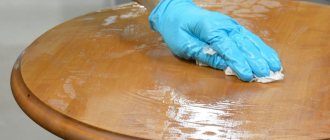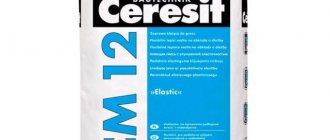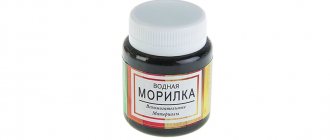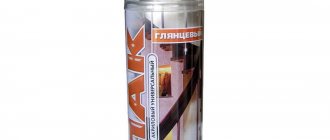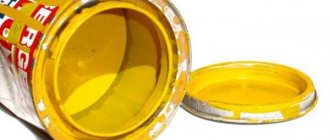Let’s imagine a situation: the car’s painting is finished, the surface is completely dry and ready for varnishing. In this case, the natural question is: what car varnish should I use? Experts have different opinions - some prefer an expensive product from a famous manufacturer, others choose budget products. And everyone is right in their own way. Let's consider some of the subtleties of storage, selection, use of aerosol varnishes and several popular brands.
Areas of application of varnishes in cans
Varnishes in cans are used in a wide range of professional fields, as well as for solving purely everyday problems.
Thus, we can distinguish three main areas of application of aerosol varnishes.
- Solving everyday problems. In this area, as a rule, I use a universal composition. Using varnishes in spray cans, various types of furniture, large toys and accessories are coated and varnished, and they add a glow to surfaces. Often, spray varnishes are used in creativity to create various works of art.
- Construction and construction business. In this case, varnishes in cans are used to varnish and add shine to surfaces and building fittings.
- Automotive industry and service. Spray varnishes are used for car body repairs, varnishing and adding shine to cars.
This, of course, is not the entire range of areas in which canned varnishes can be useful. They are also used, for example, in electronics and technical fields.
However, it is in everyday life, construction and work on cars that spray varnishes are particularly valuable and useful.
Furniture varnishing
Before you start coating furniture with a varnish composition, you need to carefully read the instructions, which indicate all the application rules. In order not to damage your health and avoid accidents, as well as to prevent damage to wood, it is important to strictly adhere to all the rules specified in the instructions. Here is a list of basic requirements for many types of varnish products:
- When applying there must be sufficient ventilation of the room;
- There should be no open flame nearby (this applies to aerosols that contain a solvent);
- It is important to carry out the application process in special clothing and personal protective equipment, such as goggles, a respirator, and gloves;
- cracks in the wood must be filled with putty before proceeding with varnishing, after which the putty must be sanded;
- the varnishing process is carried out in several layers - two or three, each layer is applied 10-15 minutes after applying the previous coating;
- Water-based formulations can be used without glasses or a respirator.
When varnishing is completed, the surface should be completely dry, this may take about 1 hour. At this time, it is better not to touch the product and take care that no mechanical damage appears on it.
Types of varnish in cans
For the most part, water-based varnishes are offered on the market. Among them, two types can be distinguished - polyurethane and acrylic varnishes, characterized by the absence of a pronounced odor, a tendency to dry quickly, elasticity and durability, environmental friendliness and fire safety.
Despite all the advantages, water-based spray varnishes also have a significant drawback - they are not very moisture resistant. Polyurethane varnishes are mostly used to protect coatings and surfaces made of wood, metal or plastic from the risk of deformation.
This protective function of polyurethane varnishes is realized due to the fact that they contain polyesters and diisocyanates, which make this type of varnish in cans resistant to influence (physical and chemical), elastic and durable.
Polyurethane varnishes, in turn, are divided into two types depending on the number of components in the composition and the need for additional preparation of the material for use:
- One-component – ready for use immediately after purchase, not requiring additional manipulations;
- Two-component - requiring special preparation before use (mixing the hardener and the paint base, and it is necessary to correctly calculate the required amount of the mixture, since it cracks and turns yellow during long-term storage).
Acrylic varnishes are a viscous, odorless, water-soluble liquid. The key element in the composition is liquid polymer (acrylic dispersion). Like polyurethane varnish, acrylic spray is durable, which is why it is actively used for varnishing, protecting and strengthening wood surfaces and products.
- However, in baths and bathtubs made in wood decor, you should not use acrylic varnishes, since they are not very resistant to water.
- However, acrylic paints are the safest for people to use and are also UV resistant.
- It is due to this that they remain on the surface for a long time when varnishing furniture.
- In addition to the above-mentioned varnishes in cans, which are basically water-based, there is also a nitrocellulose spray varnish.
- This type of varnish in cans contains organic mixtures and resin as its main elements.
It is characterized by fast drying rates and safety for humans. Can also be used to cover wooden furniture. Often used for decorative purposes. For example, for repairing or decorating cars.
Unscented varnishes
For some people, important criteria are the absence of unpleasant odors and environmental friendliness of the material. The category of consumers with allergic diseases is especially concerned about this.
Aerosol sprays with a strong odor:
- alkyd;
- polyurethane;
- nitrocellulose.
Despite their popularity and excellent qualities, nitrocellulose and polyurethane aerosols are quite dangerous to health. They contain toxic substances. Alkyd spray also has an unpleasant odor because it contains toxic extractants.
If aerosol varnish is purchased for a nursery or the main criterion is environmental friendliness, then you should pay attention to acrylic types that are water-based. This product is absolutely harmless and has no foreign odors. It is also quite durable and elastic.
Features of choosing varnish in a can
The key problem in choosing a varnish in a can is the relationship between its properties and the purposes of varnishing. As a rule, when choosing, there is hesitation between choosing a glossy or matte, colored or transparent varnish.
Glossy varnish is suitable for objects in dark colors, as well as for things that are less susceptible to deformation and damage. All of them will be noticeable if such surfaces are coated with glossy varnish. It is the glossy appearance of spray varnishes that allows you to emphasize lines and patterns and give a particularly impressive shine.
- Matte spray is convenient in the sense that its presence on the surface of things makes them easier to care for.
- Matte sprays are also suitable for those who are on a budget. As a rule, they are more economical in use and price compared to glossy varnishes.
- Also, unlike glossy varnishes, which give a more dramatic, mystical and vibrant effect, matte varnishes keep the surfaces and items being coated natural, without changing their color or texture.
However, it is important to understand that how durable the coating turns out to be depends little on whether glossy or matte varnish was used. The main criterion for durability is the manufacturer and cost of the varnish.
Speaking about which varnish to give preference to, colored or transparent, it is worth noting the following. Transparent varnish is universal, completely invisible and can be used for luxury furniture made from expensive wood.
I choose colored varnish for cheaper wood, thereby solving several problems at once.
- First, colored varnish can visually improve the quality of inexpensive wood.
- Secondly, it adds richness to the colors.
- Thirdly, it does a good job of protecting surfaces.
Revealing the problems and features of choosing varnish in a can, it is worth noting that such an aspect as choosing the color of the coating is especially problematic when it comes to colored varnish. As a rule, black or white is chosen depending on the original color of the surface. These are the most universal and frequently found colors in stores.
Why coat plastic with varnish?
It is assumed that the varnish will protect plastic products from the influence of the external environment. The second point is the decorative component of the coating to give the surfaces a characteristic glossy shine. Again, with the help of a special solution, you can enhance the depth of the color of the base or even completely change the color, creating an unusual optical effect on the surface.
Varnishing extends the service life of polymer products; the durable film prevents the possibility of mechanical damage to the base (scratches, chips, cracks). True, not everyone can use varnishes on plastic. Some solutions do not react with the base materials, but simply spread over the surface. Others don’t dry at all. Still others, after a while, begin to stick, warp, and peel off. This means that you need to choose a special solution for polymer materials. Which?
Technique for applying varnish from a can
The first step in applying varnish in a can is to thoroughly prepare the surface or base.
If we are talking about a recently applied layer of paint as a base, then the surface for application must be immaculately dry and smooth. Old layers must, among other things, be cleaned and degreased. If the surface is not properly cleaned, then after the varnish has dried, marks and bumps from old impurities will appear on the surface.
Next, you need to prepare the room itself before painting. It should be well blown or ventilated and properly lit. The room temperature should exceed 20 degrees.
After these two preparatory stages have been completed, namely the room and the base have been prepared, you can proceed directly to applying the varnish.
The procedure for working with varnish is as follows:
- It is necessary to shake the can of varnish
- Next, you need to apply a special developing layer by spraying at a distance of 35-40 cm. It is strictly forbidden to spray paint in one place for a long time, as smudges may form.
- After application, leave the product for 10 minutes to dry. Drying times may vary. As a rule, it is written in the instructions.
- Once the developing layer is high, it is necessary to apply another 2-3 layers of varnish and dry them. Drying occurs naturally or using special infrared heaters.
The remaining varnish can be used later in another varnishing process. But it is important to clean the sprayer after current use. You can do it something like this: you need to turn the container over, and then start spraying until it stops.
How to properly store the composition
A high price does not always indicate the quality of a product. Sometimes branded aerosols can actually be fake. Such situations arise when purchases are made in markets and stalls. Also, aerosol varnish may be unsuitable for use due to non-compliance with storage conditions.
The average shelf life of paint materials is about 2 years. However, in reality it may be less if the aerosol was stored in an appropriate manner.
All recommendations for storing the spray are on the label. Particular attention should be paid to the permissible temperature difference. This criterion can tell you whether it is worth purchasing the product in a given place.
For example, on the market, all cans of varnish are stored at ambient temperature. In winter it can reach 20 degrees. At this temperature, the aerosol will become unusable in a few weeks and will lose the necessary qualities. When using it, cloudiness on the surfaces is possible, and peeling of the varnish may soon occur.
Exposure to too much heat is also detrimental to aerosol can varnishes. If you store it outdoors in the summer, the hardener will begin to thicken. This will lead to the complete unsuitability of the product within a month.
Therefore, it is best to purchase paint and varnish materials in specialized stores. The main criterion when choosing should be the conditions that are created for its storage. Of course, price and manufacturer also matter. Budget options will have lower quality paint.
Expert advice (2 videos)
Aerosol varnishes of different brands (21 photos)
Advantages of varnishes in cans
Speaking about the types, features and use of varnishes in cans, it is also necessary to clarify what the specific advantages of this type of paint and varnish materials are.
- The simplicity of the compositions and their readiness for direct operation without additional tools and equipment. Varnishes in cans spray themselves, no rollers or brushes are needed. With rare exceptions, they do not need to be mixed or diluted;
- Ease of use and mobility. Due to its small and convenient format in the form of a cylinder, the varnish is easily portable and can be used in any room;
- Budget price and efficiency;
- The composition dries quickly - as a rule, it only takes a couple of minutes for the varnish to set and, often, for final drying;
- Suitable for a wide range of materials (metal, plastic, wood);
- Accessibility for use by beginners;
- Wide range of textures, types and colors.
Which is better, glossy or matte?
You also need to decide which effect is more suitable for processing the object - matte or gloss. Both options have pros and cons. The glossy type is often chosen for black and dark base shades and produces a shine that reflects beautifully on a similar color.
Due to the gloss, you can emphasize the transition of lines and patterns. For furniture, the choice of this particular type is popular because of its beauty. But even small scratches will be noticeable on a smooth surface. It is easier to wipe the base smooth.
The matte finish looks stylish; some people find it easier to maintain with a matte base; there is no need to get rid of stains. This effect is suitable when you want to highlight natural colors.
The effect is not reflected in the level of coating strength; this factor is influenced only by the composition and manufacturer.
Due to the gloss, you can emphasize the transition of lines and patterns.
Tips and tricks for choosing
It is worth noting that on the modern Russian market there are many different companies and types of spray varnishes.
It is easy for a common man, an ordinary person, to get lost in all this diversity. That is why it is especially important to understand manufacturers and brands.
So, the most famous, popular and reliable are:
- Mobilehel 1K. Good and proven when varnishing cars. It is characterized by transparency, density and high drying speed.
- Brulex. Acrylic varnish, mostly used for decorative purposes, to add shine and shine to metal, plastic or wood. Not subject to yellowing, dries quickly.
- Holex. Acrylic spray varnish, especially popular for painting car bodies due to its fast drying, durability and durability.
Also, when using varnishes in spray cans, you must always keep the following tips in mind.
- First, always practice in an inconspicuous place or additional surface.
- Secondly, never forget to shake the can before use.
- Fourth, follow safety measures: wear protective gloves, respirators and other devices recommended by manufacturers.
All these tips and the information discussed above about varnishes in cans will help you make the right choice when purchasing varnish and then applying it correctly.

